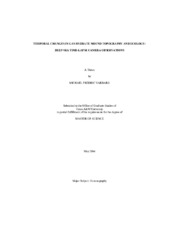| dc.description.abstract | A deep-sea time-lapse camera and several temperature probes were deployed on the Gulf of Mexico continental shelf at a biological community associated with a gas hydrate outcropping to study topographic and hydrologic changes over time. The deployment site, Bush Hill (GC 185), is located at 27°47.5' N and 91°15.0' W at depths of ~540m. The digital camera recorded one still image every six hours for three months in 2001, every two hours for the month of June 2002 and every six hours for the month of July 2002. Temperature probes were in place at the site for the entire experimental period. The data recovered provide a record of processes that occur at gas hydrate mounds. Biological activity was documented by identifying the fauna observed in the time-lapse record and recording the number of individuals and species in each image. 1,381 individual organisms representing 16 species were observed. Sediment resuspension and redistribution were regular occurrences during the deployment periods. By digitally analyzing the luminosity of the water column above the mound and plotting the results over time, the turbidity at the site was quantified. A significant diurnal pattern can be seen in both luminosity and temperature records, indicating a possible tidal or inertial component to deep-sea currents in this area. Contrary to expectations, there was no major change in shape or size of the gas hydrate outcrop at this site on the time frame of this study. This indicates that this particular mound was more stable than suggested by laboratory studies and prior in situ observations. The stable topography of the gas hydrate mound combined with high bacterial activity and sediment turnover appears to focus benthic predatory activity in the mound area. The frequency and recurrence of sediment resuspension indicates that short-term change in the depth and distribution of surface sediments is a feature of the benthos at the site. Because the sediment interface is a critical environment for hydrocarbon oxidation and chemosynthesis, short-term variability and heterogeneity may be important characteristics of these settings. | en |


